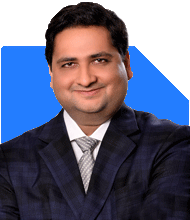Hardik Parikh | Answer |Ask -Follow
Tax, Mutual Fund Expert - Answered on Apr 19, 2023
He also holds an MBA degree from IIM-Indore.
Hardik, who began his career as an equity research analyst, founded his own advisory firm, Hardik Parikh Associates LLP, which provides a variety of financial services to clients.
He is committed to sharing his knowledge and helping others learn more about finance. He also speaks about valuation at different forums, such as study groups of the Western India Regional Council of Chartered Accountants.... more

Dear rediffGurus, I am 52 yrs and in pvt. employment with a net salary of 50k. Till not expect EPF corpus, I dont have and other savings or an home. Now that I want to buy a home and have some corpus for my retired life in another 8 years. I can make a saving of Rs 40K pm. Pl. advice how to plan. P Saravanan
Thank you for reaching out for financial advice. It's never too late to start planning for your retirement and building a corpus for a comfortable life. Based on the information you've provided, let's work out a plan to help you achieve your goals.
Emergency Fund: First and foremost, it's crucial to build an emergency fund that can cover 3-6 months of your living expenses. This will serve as a financial cushion in case of unexpected situations. Allocate a portion of your monthly savings towards building this fund.
Home Purchase: Since you're looking to buy a home, consider taking a home loan instead of utilizing your entire savings. Aim for a down payment of 20-30% of the property value, and ensure that the EMI doesn't exceed 40% of your monthly income. This will allow you to continue saving and investing for your retirement.
Retirement Corpus: With 8 years left for retirement, you can still build a substantial corpus. Since you can save Rs 40,000 per month, allocate a portion of this amount towards investments that can provide a good balance of growth and stability.
a. Equity Mutual Funds: Consider investing in a mix of large-cap, mid-cap, and small-cap equity mutual funds through a Systematic Investment Plan (SIP). This will help you benefit from the power of compounding and potentially provide higher returns in the long run.
b. Fixed Deposits & Debt Funds: Allocate a portion of your savings to fixed deposits and debt funds to ensure capital preservation and stable returns. These instruments can help balance the risk from equity investments.
c. National Pension System (NPS): You can also consider investing in the National Pension System (NPS) for additional tax benefits and a regular income stream after retirement.
Health Insurance: At your age, having adequate health insurance coverage is crucial. If you don't already have one, consider purchasing a comprehensive health insurance policy to cover any potential medical expenses.
Revisit and Adjust: Regularly review your financial plan and investments to ensure they are aligned with your goals. Make necessary adjustments based on your life situation, market conditions, and investment performance.
In summary, prioritize building an emergency fund, take a balanced approach to investing, and maintain a disciplined savings habit. Consult with a certified financial planner for personalized advice and guidance tailored to your specific needs and risk tolerance.
Wishing you the best on your financial journey!
Warm regards,
You may like to see similar questions and answers below
Vivek Lala |323 Answers |Ask -Follow
Tax, MF Expert - Answered on Jun 04, 2023
Ramalingam Kalirajan |10879 Answers |Ask -Follow
Mutual Funds, Financial Planning Expert - Answered on Apr 16, 2024
Ramalingam Kalirajan |10879 Answers |Ask -Follow
Mutual Funds, Financial Planning Expert - Answered on Jun 25, 2024
Ramalingam Kalirajan |10879 Answers |Ask -Follow
Mutual Funds, Financial Planning Expert - Answered on Feb 27, 2025
Ramalingam Kalirajan |10879 Answers |Ask -Follow
Mutual Funds, Financial Planning Expert - Answered on Jun 21, 2025
Mayank Chandel |2572 Answers |Ask -Follow
IIT-JEE, NEET-UG, SAT, CLAT, CA, CS Exam Expert - Answered on Dec 11, 2025
Mayank Chandel |2572 Answers |Ask -Follow
IIT-JEE, NEET-UG, SAT, CLAT, CA, CS Exam Expert - Answered on Dec 11, 2025
Ramalingam Kalirajan |10879 Answers |Ask -Follow
Mutual Funds, Financial Planning Expert - Answered on Dec 11, 2025
Samraat Jadhav |2507 Answers |Ask -Follow
Stock Market Expert - Answered on Dec 11, 2025
Samraat Jadhav |2507 Answers |Ask -Follow
Stock Market Expert - Answered on Dec 11, 2025
Samraat Jadhav |2507 Answers |Ask -Follow
Stock Market Expert - Answered on Dec 11, 2025
Samraat Jadhav |2507 Answers |Ask -Follow
Stock Market Expert - Answered on Dec 11, 2025
Dr Nagarajan J S K |2577 Answers |Ask -Follow
NEET, Medical, Pharmacy Careers - Answered on Dec 10, 2025
Mayank Chandel |2572 Answers |Ask -Follow
IIT-JEE, NEET-UG, SAT, CLAT, CA, CS Exam Expert - Answered on Dec 10, 2025
Samraat Jadhav |2507 Answers |Ask -Follow
Stock Market Expert - Answered on Dec 10, 2025
























